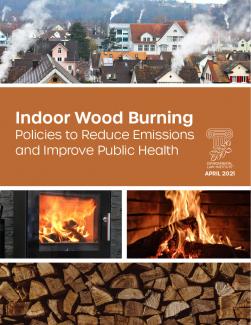
Smoke from residential wood burning is composed of many substances, including particulate matter, carbon monoxide, nitrogen oxides, and toxic chemicals such as benzene, formaldehyde, and polycyclic aromatic hydrocarbons. A wide range of serious health effects are associated with exposure to these pollutants – most prominently fine particulate matter (PM2.5), which is linked to cardiovascular disease, respiratory disease, cancer, and other systemic health effects.
Smoke from indoor wood burning affects both ambient and indoor air quality. Smoke that goes out a chimney can reenter the same home and enter the homes of neighbors. Smoke can also escape a wood-burning device directly into the interior living space. Many jurisdictions can benefit from stronger policies and programs that protect public health by reducing emissions from residential wood-burning devices such as woodstoves and fireplaces.
Overview of the Report
This report describes a variety of policy strategies that have been adopted at the state, local, regional, and tribal levels to advance two complementary goals: (1) changing how and when wood is burned in homes, in order to reduce emissions from existing wood-burning devices; and (2) replacing existing wood-burning devices with lower-emitting devices, including non-wood alternatives. The report highlights examples of laws and regulations that incorporate the following strategies.
Tightening Device Emissions and Approval Standards. Some jurisdictions restrict wood burning – in certain situations or in designated air quality zones – to devices that meet a specified emissions
standard or have been approved by a designated state, local, or tribal agency. The report notes an important consideration relevant to this policy approach: whether federal testing methods for certifying new wood heater emission standards reflect the conditions of actual use and whether new devices may emit more pollutants when used in the home than when tested in the lab.
Prohibiting the Transfer of Noncompliant Wood-Burning Devices. A number of policies broadly restrict the transfer of devices that do not meet specified emissions and certification standards. Several
jurisdictions have taken the notable step of prohibiting the transfer of noncompliant devices when a home is sold – an opportunity to expedite the removal of older wood heaters. A small number of jurisdictions have gone further to ban the use (and/or require the removal) of certain noncompliant wood heaters in existing homes.
Limiting Burning During Designated Periods of Poor Air Quality. Many jurisdictions, especially those with air quality nonattainment areas, have established “curtailment” programs that restrict or prohibit wood burning when ambient particulate matter levels are elevated.
Setting Performance Standards that Apply to Wood Smoke. Many jurisdictions limit the opacity of smoke leaving chimneys, and some go further to prohibit “visible emissions.” These standards can help implement other regulatory restrictions, and on their own they can serve as tools for addressing public complaints about wood smoke impacts.
Establishing Operating and Maintenance Requirements for Wood-Burning Devices. How a wood heater is operated is important for reducing emissions. In some jurisdictions, air quality rules or housing codes include general requirements that devices be properly operated and maintained. Additionally, many jurisdictions prohibit the burning of certain materials, and some specifically require the use of seasoned/dry wood, an important measure for controlling emissions.
Establishing Financial Assistance Programs to Help Households Reduce Emissions and Meet Regulatory Requirements. A variety of financial assistance programs have been established to help households replace older wood-burning devices and to adopt other practices to reduce emissions.
For programs funding the replacement of older wood heaters, a key issue is what type of new heating devices should be subsidized with government funds.
The context for developing policies to address wood smoke includes a long history of wood burning tied to important economic, social, and cultural systems. Outreach programs that provide culturally relevant information are important for increasing awareness of the health risks posed by wood smoke and of the wood-burning practices that are needed to minimize emissions. A robust public participation process is important to identify opportunities for collaboration among agencies and community members and to build public support for policies and programs.
Explore other materials from ELI’s Indoor Environments Program.
© Environmental Law Institute®